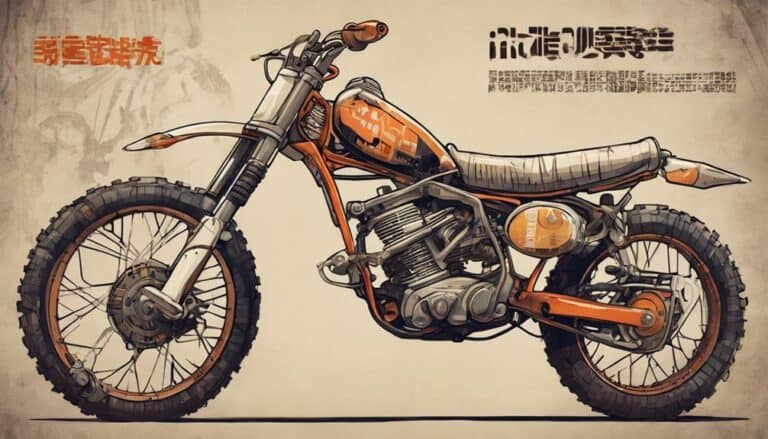In the evolution of dirt bike technology, there came a pivotal moment when fuel pumps replaced carburetors as the preferred fuel delivery system.
The significance of this shift lies not only in its impact on performance but also in the overall efficiency and environmental considerations it brought to the table.
As you ponder the question of when this alteration occurred, you might find yourself intrigued by the intricate dance between tradition and innovation that shaped the modern dirt bike industry.
Stay tuned to discover the compelling narrative behind this pivotal change in fuel delivery systems.
Key Takeaways
- Late 1990s marked the transition to fuel pumps for precise fuel delivery in dirt bikes.
- Fuel pumps replaced carburetors for better air/fuel mixture control and emissions compliance.
- Fuel pump technology significantly improved engine performance and efficiency.
- Manufacturers shifted to fuel pumps for reliability, performance, and compliance with regulations.
Evolution of Fuel Delivery Systems in Dirt Bikes
In the late 1990s, dirt bikes began incorporating fuel pumps as a replacement for carburetors to achieve more accurate fuel delivery and comply with emissions standards. This change marked an important evolution in fuel delivery systems for dirt bikes, particularly in enhancing engine performance.
Fuel pumps enabled better control of the air/fuel mixture, leading to cleaner combustion and improved efficiency. For Two Strokes engines, this shift to fuel injection systems meant a significant advancement in technology, allowing for more precise fuel delivery and optimized combustion processes.
Manufacturers embraced fuel pumps not only to meet regulatory requirements but also to enhance the overall reliability and performance of dirt bikes. The adoption of fuel injection systems over carburetors in dirt bikes represented a major leap forward in the quest for more efficient and powerful off-road motorcycles.
Transition From Carburetors to Fuel Pumps
The shift from carburetors to fuel pumps in dirt bikes during the late 1990s marked a pivotal advancement in fuel delivery systems. This change emphasized precise control of the air/fuel mixture for enhanced performance and compliance with emissions standards.
Fuel pumps, integral components of fuel injection systems, offer superior fuel delivery accuracy compared to carburetors. This transition was primarily motivated by the necessity to meet stringent emissions control requirements and enhance overall efficiency.
Fuel pumps enable constant adjustment of the fuel map, resulting in cleaner combustion processes and reduced environmental impact. By facilitating precise control of the air/fuel ratio, fuel pumps in dirt bikes contribute to improved gas mileage and a smoother operational experience.
The elimination of manual choke adjustments further streamlines the fuel delivery process, enhancing the bike's performance capabilities. Embracing fuel pumps over carburetors signifies a significant leap towards modernizing dirt bike technology and aligning with contemporary environmental standards.
Milestones in Fuel Pump Adoption on Dirt Bikes
Amidst the evolutionary timeline of dirt bike technology, a notable shift occurred with the integration of fuel pumps instead of carburetors, revolutionizing fuel delivery systems and elevating performance standards. This marked a significant milestone in the constant quest for improved efficiency and reliability in dirt bikes.
- Fuel pumps enabled precise fuel delivery, optimizing the combustion process and enhancing engine performance.
- The adoption of fuel pumps eliminated the reliance on gravity-fed fuel systems, ensuring consistent fuel flow irrespective of the bike's orientation.
- Manufacturers such as KTM and Husqvarna were pioneers in embracing fuel pump technology for dirt bikes, setting the stage for enhanced fuel delivery systems industry-wide.
The substitution to fuel pumps not only streamlined fuel delivery but also paved the way for advancements in engine performance, marking a new era in dirt bike technology. As riders seek greater control and efficiency, the integration of fuel pumps has become a standard bearer for improved performance on the trails.
Impact of Fuel Pump Technology on Performance
Fuel pump technology revolutionized dirt bike performance by enhancing fuel delivery accuracy and efficiency, resulting in improved throttle response and smoother power delivery. The shift from carburetors to fuel injection systems marked a significant improvement in how fuel is supplied to combustion engines.
This advancement optimized the air-fuel mixture, leading to better combustion and increased performance in dirt bikes. The precise delivery of fuel by the fuel pump also plays an important role in achieving cleaner emissions, meeting strict environmental regulations.
The efficiency of fuel injection systems guarantees that the engine receives the right amount of fuel at the right time, maximizing power output while minimizing waste. Overall, the impact of fuel pump technology on dirt bike performance can't be overstated, as it has elevated throttle response, overall efficiency, and emission control, setting new standards in the world of off-road motorcycle engineering.
Future Trends in Dirt Bike Fuel Systems
In the domain of dirt bike engineering, the evolution of fuel delivery systems continues to drive innovations towards future trends in fuel systems. The next generation of dirt bike fuel systems is poised to revolutionize the riding experience by focusing on fuel injection technology.
- Fuel Injection: The future of dirt bike fuel systems lies in advanced fuel injection technology, which offers precise control over the fuel delivery process.
- Enhanced Fuel Efficiency: Manufacturers are working towards developing fuel systems that optimize fuel efficiency, ensuring longer rides with minimal fuel consumption.
- Emission Reduction: The upcoming fuel systems aim to reduce emissions by delivering the best air/fuel mixture to the combustion chamber, resulting in cleaner exhaust and reduced environmental impact.
These future trends in dirt bike fuel systems highlight a shift towards more sustainable and high-performance solutions, catering to the evolving needs of riders while promoting environmental responsibility.
Conclusion
You thought carburetors were the king of fuel delivery systems in dirt bikes, but fuel pumps took over the throne in the blink of an eye.
The evolution from carburetors to fuel injection systems was swift and decisive, revolutionizing the way dirt bikes perform.
So next time you hit the trails, remember that the fuel pump is the true MVP, providing precise control and cleaner emissions for a smoother ride.

